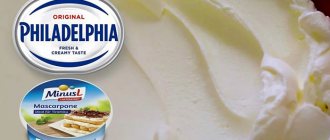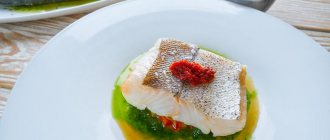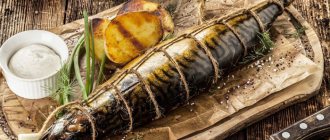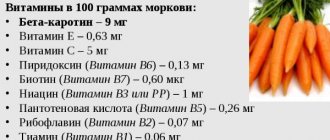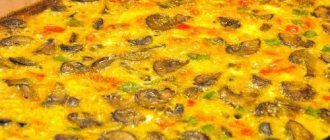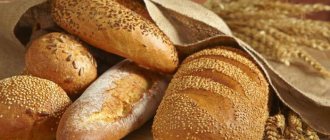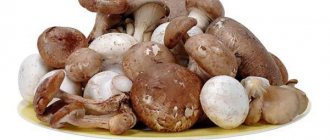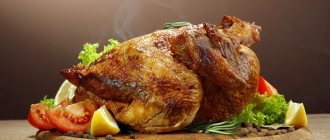Composition of sausages
Sausages, invented by German butchers in 1805, have been prepared in our country since 1936.
But if in Soviet times they contained about 50% minced meat, then modern sausages contain animal fat, skin, and poultry meat.
Sausages are a popular fast food product
For taste, manufacturers add soy, vegetable oil, salt, preservatives, dietary supplements, stabilizers and other additives.
The content of protein-fat emulsions, nitrates, and nitrites in sausages causes addiction in humans.
Their consumption is the cause of food allergies in children, digestive disorders, and even poisoning.
Calories in sausage
The calorie content of sausage products depends on the weight of the product and the meat content in it. When calculating the energy value, the type and quantity of meat components, artificial additives, and soy protein are important.
The approximate number of calories per 100 g of boiled product is 239 . If the average weight of one sausage is 50-60 grams, its calorie content is 120-143 kcal.
Calorie content of milk sausages
Milk sausages are considered a dietary product; they can even be given to children in small quantities.
Milk sausages are considered a dietary product
They contain lean poultry meat, milk powder, and the percentage of chemical impurities is less than in other types of products. The energy value of dairy sausage products is 133 calories per 100 g.
Sausages with cheese
Among the variety of types of sausages in the assortment of stores, there are cheese sausages. When making the product, cheese is added to the meat filling.
High-quality sausages contain hard cheese , a source of vitamins A, B, and PP.
If the recipe contains two components: natural pork (beef, poultry) and hard cheese, the product can be safely included in the diet. In fact, the manufacturer saves on raw materials by adding cheap cheese or processed product.
Due to the fat content of the cheese, the calorie content increases: 100 g of cheese sausages contain 266 calories.
Calorie content of sausage in dough, hot dog
The hot dog is considered a traditionally American invention.
Calorie content of sausage in dough, hot dog
Indeed, thanks to enterprising Americans, German sausages baked in dough are still firmly at the peak of popularity among snacks.
The nutritional value of 100 grams is on average 350 kcal and depends on the type of minced meat and the amount of dough in which the sausage is wrapped.
The recipe for the dish is simple - the sausage is wrapped in a strip of yeast dough, then baked in the oven for 20-30 minutes.
Recipe Fried sausages in dough. Calorie, chemical composition and nutritional value.
| Wheat flour, premium (Frying) | 500 g |
| Water | 160 g |
| Milk 3.2% fat, pasteurized (Frying) | 160 g |
| Table salt | 1 g |
| Granulated sugar | 1.5 g |
| Sunflower oil | 7 g |
| Baking powder, yeast, baker's, active, dry | 11 g |
| Sausages, dairy | 15 g |
In a large cup, combine warm milk and water, add sugar and yeast, leave for 15 minutes. Then add 6 tablespoons of vegetable oil, salt, sifted flour, knead a soft dough that slightly sticks to your hands.
Cover the pan with the dough with a towel or lid and place in a warm place for 2 hours (knead 1-2 times). Grease the work surface and hands well with vegetable oil, divide the dough into equal balls (the size of an egg). Knead each ball thoroughly or roll it out, add a sausage. Bring the edges of the dough together and seal, forming an oblong pie. So form all the pies. Immediately place in a heated (but not hot!!!) frying pan with plenty of vegetable oil, fry the sausages in the dough over medium heat until golden brown on both sides. Place the finished pies on a paper towel to absorb excess oil. Then transfer to a dish and serve delicious fried sausages in dough! You can create your own recipe taking into account the loss of vitamins and minerals using the recipe calculator in the “My Healthy Diet” application.
Chemical composition and nutritional analysis
Nutritional value and chemical composition of “Fried sausages in dough.”
The table shows the nutritional content (calories, proteins, fats, carbohydrates, vitamins and minerals) per 100 grams of edible portion.
| Nutrient | Quantity | Norm** | % of the norm in 100 g | % of the norm in 100 kcal | 100% normal |
| Calorie content | 310.6 kcal | 1684 kcal | 18.4% | 5.9% | 542 g |
| Squirrels | 9 g | 76 g | 11.8% | 3.8% | 844 g |
| Fats | 19.6 g | 56 g | 35% | 11.3% | 286 g |
| Carbohydrates | 24.4 g | 219 g | 11.1% | 3.6% | 898 g |
| Alimentary fiber | 1.3 g | 20 g | 6.5% | 2.1% | 1538 g |
| Water | 48.8 g | 2273 g | 2.1% | 0.7% | 4658 g |
| Ash | 2.004 g | ~ | |||
| Vitamins | |||||
| Vitamin A, RE | 2.1 mcg | 900 mcg | 0.2% | 0.1% | 42857 g |
| Retinol | 0.002 mg | ~ | |||
| beta carotene | 0.001 mg | 5 mg | 500000 g | ||
| Vitamin B1, thiamine | 0.219 mg | 1.5 mg | 14.6% | 4.7% | 685 g |
| Vitamin B2, riboflavin | 0.125 mg | 1.8 mg | 6.9% | 2.2% | 1440 g |
| Vitamin B4, choline | 17.3 mg | 500 mg | 3.5% | 1.1% | 2890 g |
| Vitamin B5, pantothenic | 0.22 mg | 5 mg | 4.4% | 1.4% | 2273 g |
| Vitamin B6, pyridoxine | 0.064 mg | 2 mg | 3.2% | 1% | 3125 g |
| Vitamin B9, folates | 23.602 mcg | 400 mcg | 5.9% | 1.9% | 1695 g |
| Vitamin B12, cobalamin | 0.039 mcg | 3 mcg | 1.3% | 0.4% | 7692 g |
| Vitamin C, ascorbic acid | 0.07 mg | 90 mg | 0.1% | 128571 g | |
| Vitamin D, calciferol | 0.005 mcg | 10 mcg | 0.1% | 200000 g | |
| Vitamin E, alpha tocopherol, TE | 3.938 mg | 15 mg | 26.3% | 8.5% | 381 g |
| Vitamin H, biotin | 0.901 mcg | 50 mcg | 1.8% | 0.6% | 5549 g |
| Vitamin K, phylloquinone | 0.5 mcg | 120 mcg | 0.4% | 0.1% | 24000 g |
| Vitamin RR, NE | 3.4488 mg | 20 mg | 17.2% | 5.5% | 580 g |
| Niacin | 1.484 mg | ~ | |||
| Betaine | 0.024 mg | ~ | |||
| Macronutrients | |||||
| Potassium, K | 162.74 mg | 2500 mg | 6.5% | 2.1% | 1536 g |
| Calcium, Ca | 35.23 mg | 1000 mg | 3.5% | 1.1% | 2838 g |
| Silicon, Si | 1.218 mg | 30 mg | 4.1% | 1.3% | 2463 g |
| Magnesium, Mg | 16.19 mg | 400 mg | 4% | 1.3% | 2471 g |
| Sodium, Na | 512.84 mg | 1300 mg | 39.4% | 12.7% | 253 g |
| Sera, S | 79.44 mg | 1000 mg | 7.9% | 2.5% | 1259 g |
| Phosphorus, P | 115.2 mg | 800 mg | 14.4% | 4.6% | 694 g |
| Chlorine, Cl | 206.31 mg | 2300 mg | 9% | 2.9% | 1115 g |
| Microelements | |||||
| Aluminium, Al | 324.4 mcg | ~ | |||
| Bor, B | 11.3 mcg | ~ | |||
| Vanadium, V | 27.39 mcg | ~ | |||
| Iron, Fe | 1.263 mg | 18 mg | 7% | 2.3% | 1425 g |
| Yod, I | 0.71 mcg | 150 mcg | 0.5% | 0.2% | 21127 g |
| Cobalt, Co | 0.615 mcg | 10 mcg | 6.2% | 2% | 1626 g |
| Manganese, Mn | 0.1772 mg | 2 mg | 8.9% | 2.9% | 1129 g |
| Copper, Cu | 35.99 mcg | 1000 mcg | 3.6% | 1.2% | 2779 g |
| Molybdenum, Mo | 4.793 mcg | 70 mcg | 6.8% | 2.2% | 1460 g |
| Nickel, Ni | 0.67 mcg | ~ | |||
| Tin, Sn | 2.82 mcg | ~ | |||
| Selenium, Se | 1.77 mcg | 55 mcg | 3.2% | 1% | 3107 g |
| Strontium, Sr | 1.62 mcg | ~ | |||
| Titanium, Ti | 3.35 mcg | ~ | |||
| Fluorine, F | 18.76 mcg | 4000 mcg | 0.5% | 0.2% | 21322 g |
| Chromium, Cr | 0.86 mcg | 50 mcg | 1.7% | 0.5% | 5814 g |
| Zinc, Zn | 0.3133 mg | 12 mg | 2.6% | 0.8% | 3830 g |
| Digestible carbohydrates | |||||
| Starch and dextrins | 20.666 g | ~ | |||
| Mono- and disaccharides (sugars) | 3.3 g | max 100 g | |||
| Essential amino acids | |||||
| Arginine* | 0.295 g | ~ | |||
| Valin | 0.316 g | ~ | |||
| Histidine* | 0.149 g | ~ | |||
| Isoleucine | 0.284 g | ~ | |||
| Leucine | 0.382 g | ~ | |||
| Lysine | 0.422 g | ~ | |||
| Methionine | 0.056 g | ~ | |||
| Methionine + Cysteine | 0.128 g | ~ | |||
| Threonine | 0.185 g | ~ | |||
| Tryptophan | 0.099 g | ~ | |||
| Phenylalanine | 0.188 g | ~ | |||
| Phenylalanine+Tyrosine | 0.328 g | ~ | |||
| Nonessential amino acids | |||||
| Alanin | 0.325 g | ~ | |||
| Aspartic acid | 0.5 g | ~ | |||
| Hydroxyproline | 0.086 g | ~ | |||
| Glycine | 0.318 g | ~ | |||
| Glutamic acid | 0.854 g | ~ | |||
| Proline | 0.268 g | ~ | |||
| Serin | 0.218 g | ~ | |||
| Tyrosine | 0.16 g | ~ | |||
| Cysteine | 0.08 g | ~ | |||
| Sterols (sterols) | |||||
| Cholesterol | 25.58 mg | max 300 mg | |||
| beta sitosterol | 15.092 mg | ~ | |||
| Saturated fatty acids | |||||
| Saturated fatty acids | 4.4 g | max 18.7 g | |||
| 16:0 Palmitinaya | 0.473 g | ~ | |||
| 18:0 Stearic | 0.311 g | ~ | |||
| 20:0 Arakhinovaya | 0.023 g | ~ | |||
| 22:0 Begenovaya | 0.053 g | ~ | |||
| Monounsaturated fatty acids | 1.918 g | min 16.8 g | 11.4% | 3.7% | |
| 16:1 Palmitoleic | 0.016 g | ~ | |||
| 18:1 Oleic (omega-9) | 1.802 g | ~ | |||
| Polyunsaturated fatty acids | 4.923 g | from 11.2 to 20.6 g | 44% | 14.2% | |
| 18:2 Linolevaya | 4.513 g | ~ | |||
| Omega-6 fatty acids | 4.6 g | from 4.7 to 16.8 g | 97.9% | 31.5% |
Calorie content by different manufacturers
The energy value of sausages depends on the quantity and quality of ingredients. If the basis is soy protein, animal by-products, starch, preservatives, caloric content will increase.
The more natural substances in the product, the fewer calories.
Calorie content of sausage products from different manufacturers:
| Product Variety | "Rati-mir" | "Remit" | "More meats" | "Moor" | "Ostankino" | Malakhovsky meat processing plant | "Own line" |
| “Doctor’s”, kcal/100 g | 305 | 300 | 246 | 163 | 290 | 190 | 249,5 |
| “Dairy”, kcal/100 g | 281 | 296 | 300 | 296 | 296 | 296 | 233 |
| “Viennese”, kcal/100 g | 255 | 294 | 230 | -* | 246 | -* | 202 |
-* products are not produced
Calorie content of sausages, composition of BZHU, benefits and harms
Although sausages are commonly classified as meat products, most of them do not contain meat. To lose weight, you should choose brands that are not high in calories. Nutritionists have even developed special diets that involve eating sausages.
The greatest number of calories is contained in creamy products, the least in boiled products. High-quality sausages are worth eating for their vitamins. But you should also familiarize yourself with their possible harm and contraindications.
The calorie content of products and nutritional value (content of proteins, fats, carbohydrates) vary depending on the type and method of preparation of the product. The number of calories and composition in a sausage per 100 grams is indicated in the table:
Calorie content, BJU
The calculation of BJU is the calculation of the number of calories in a dish with the determination of their optimal ratio in proteins, fats and carbohydrates. It varies depending on the individual characteristics of the body, age category and dietary goals. Protein serves as the basis for tissue formation and contains useful amino acids.
Fats are necessary for metabolism and cell functioning. Carbohydrates promote energy and keep the body in good shape. In various situations, the proportionality of the calorie content in these substances is responsible for weight gain and loss, and affects the appearance and general condition of the body.
The BJU indicators of ordinary sausages in the dough are given in portions and in total based on the amount of products, which corresponds to 11 servings without taking into account frying and boiling of ingredients.
| Components | Quantity | Weight | Protein | Fat | Carbohydrates | Calorie content |
| Sunflower oil | 2.7 tbsp. l. | 20 g | 0 g | 19.98 g | 0 g | 179.8 kcal |
| Egg | 1 PC. | 47 g | 5.97 g | 5.12 g | 0.33 g | 73.79 kcal |
| Milk sausages | 11 pcs. | 300 g | 33 g | 71.7 g | 4.8 g | 798 kcal |
| Yeast puff pastry cherry | 450 g | 450 g | 27.9 g | 96.75 g | 179.1 g | 1701 kcal |
| 100 g dish | 1.25 servings | 100 g | 8.2 g | 23.7 g | 22.5 g | 336.9 kcal |
| 1 serving | 1 PC. | 74 g | 6.1 g | 17.6 g | 16.7 g | 250.2 kcal |
| Total | 11 pcs. | 817 g | 66.9 g | 193.6 g | 184.2 g | 2752.6 kcal |
Ingredients of sausages in dough
Full recipe recipe – Sausages in dough
Please note that the total calorie content of all products is calculated here, unlike the recipe page, where it is indicated for 1 serving.
| product | measure | weight | kcal | fats | squirrels | carbohydrates |
| sausages | 14 pieces | 770 | 1755.6 | 154 | 92.4 | |
| butter | 50 grams | 50 | 373.75 | 41.25 | 0.25 | 0.4 |
| pasteurized milk 1.5% | 250 milliliters | 250 | 108.75 | 3.75 | 7.5 | 12 |
| egg | 1 piece | 55 | 86.3 | 6.33 | 6.99 | 0.39 |
| flour | 450 grams | 450 | 1351.35 | 5.85 | 45 | 298.35 |
| yeast | 15 grams | 15 | 11.27 | 0.41 | 1.91 | |
| sugar | 1.5 teaspoon | 10.5 | 39.3 | 10.48 | ||
| salt | 1 teaspoon | 10 | ||||
| Total amount | 1610.5 | 3726.31 | 211.58 | 154.04 | 321.61 | |
| Total per 100 grams | 231.38 | 13.14 | 9.56 | 19.97 |
| vitamins, minerals (recipe ingredients): | |||||
| Vitamin B1 | 4.74 mg. | Vitamin B2 | 4.82 mg. | Vitamin PP | 25.8 mg. |
| Iron | 23.72 mg. | Potassium | 3.31 g. | Calcium | 870.26 mg. |
| Magnesium | 421.57 mg. | Sodium | 6.47 g. | Phosphorus | 3.1 g. |
| Iodine | 0.09 mg. | Vitamin A | 0.72 mg. | Vitamin B3 | 2.37 mg. |
| Vitamin E | 66.83 mg. | Vitamin D | 0.1 mg. | Vitamin B6 | 2.52 mg. |
| Vitamin B9 | 0.24 mg. | Vitamin H | 0.02 mg. | Vitamin C | 3.25 mg. |
| Vitamin B12 | 1.28 mcg. | Cholesterol | 326 mg. | Sulfur | 551.8 mg. |
| Chlorine | 6.33 g. | ||||
Product compatibility in the recipe:
Well compatible: flour - butter.
Acceptable: milk - butter.
Poorly compatible: butter - sausages, milk - sausages, chicken egg - sausages, chicken egg - butter, chicken egg - milk, flour - sausages, flour - milk, flour - chicken egg, sugar - sausages, sugar - butter, sugar - milk, sugar - chicken egg, sugar - flour, chicken yolk - sausages, chicken yolk - butter, chicken yolk - milk, chicken yolk - flour, chicken yolk - sugar.
Sausage in dough in other portions:
350
3.5
| Qty | A portion | Calories | In the counter |
| 100 g | 350 | ||
| 1 g | 3.5 | ||
| 99 | 1 ounce = 28.35g | 99 | |
| 210 | 1 small = 60g | 210 | |
| 420 | 1 large = 120g | 420 |
Composition of sausages
Sausages, invented by German butchers in 1805, have been prepared in our country since 1936.
But if in Soviet times they contained about 50% minced meat, then modern sausages contain animal fat, skin, and poultry meat.
For taste, manufacturers add soy, vegetable oil, salt, preservatives, dietary supplements, stabilizers and other additives.
The content of protein-fat emulsions, nitrates, and nitrites in sausages causes addiction in humans.
Their consumption is the cause of food allergies in children, digestive disorders, and even poisoning.
Calories in sausage
The calorie content of sausage products depends on the weight of the product and the meat content in it. When calculating the energy value, the type and quantity of meat components, artificial additives, and soy protein are important.
The approximate number of calories per 100 g of boiled product is 239 . If the average weight of one sausage is 50-60 grams, its calorie content is 120-143 kcal.
Calorie content of milk sausages
Milk sausages are considered a dietary product; they can even be given to children in small quantities.
They contain lean poultry meat, milk powder, and the percentage of chemical impurities is less than in other types of products. The energy value of dairy sausage products is 133 calories per 100 g.
Sausages with cheese
Among the variety of types of sausages in the assortment of stores, there are cheese sausages. When making the product, cheese is added to the meat filling.
High-quality sausages contain hard cheese , a source of vitamins A, B, and PP.
If the recipe contains two components: natural pork (beef, poultry) and hard cheese, the product can be safely included in the diet. In fact, the manufacturer saves on raw materials by adding cheap cheese or processed product.
Due to the fat content of the cheese, the calorie content increases: 100 g of cheese sausages contain 266 calories.
Calorie content of sausage in dough, hot dog
The hot dog is considered a traditionally American invention.
Indeed, thanks to enterprising Americans, German sausages baked in dough are still firmly at the peak of popularity among snacks.
The nutritional value of 100 grams is on average 350 kcal and depends on the type of minced meat and the amount of dough in which the sausage is wrapped.
The recipe for the dish is simple - the sausage is wrapped in a strip of yeast dough, then baked in the oven for 20-30 minutes.
Recipe: Sausage in yeast dough. Calorie, chemical composition and nutritional value.
Nutritional value and chemical composition of “Sausage in yeast dough.”
The table shows the nutritional content (calories, proteins, fats, carbohydrates, vitamins and minerals) per 100 grams of edible portion.
| Nutrient | Quantity | Norm** | % of the norm in 100 g | % of the norm in 100 kcal | 100% normal |
| Calorie content | 290.9 kcal | 1684 kcal | 17.3% | 5.9% | 579 g |
| Squirrels | 9.4 g | 76 g | 12.4% | 4.3% | 809 g |
| Fats | 15 g | 56 g | 26.8% | 9.2% | 373 g |
| Carbohydrates | 29.6 g | 219 g | 13.5% | 4.6% | 740 g |
| Alimentary fiber | 1.3 g | 20 g | 6.5% | 2.2% | 1538 g |
| Water | 48.2 g | 2273 g | 2.1% | 0.7% | 4716 g |
| Ash | 1.576 g | ~ | |||
| Vitamins | |||||
| Vitamin A, RE | 22.3 mcg | 900 mcg | 2.5% | 0.9% | 4036 g |
| Retinol | 0.02 mg | ~ | |||
| beta carotene | 0.015 mg | 5 mg | 0.3% | 0.1% | 33333 g |
| Vitamin B1, thiamine | 0.138 mg | 1.5 mg | 9.2% | 3.2% | 1087 g |
| Vitamin B2, riboflavin | 0.087 mg | 1.8 mg | 4.8% | 1.7% | 2069 g |
| Vitamin B4, choline | 20.59 mg | 500 mg | 4.1% | 1.4% | 2428 g |
| Vitamin B5, pantothenic | 0.119 mg | 5 mg | 2.4% | 0.8% | 4202 g |
| Vitamin B6, pyridoxine | 0.067 mg | 2 mg | 3.4% | 1.2% | 2985 g |
| Vitamin B9, folates | 10.731 mcg | 400 mcg | 2.7% | 0.9% | 3728 g |
| Vitamin D, calciferol | 0.064 mcg | 10 mcg | 0.6% | 0.2% | 15625 g |
| Vitamin E, alpha tocopherol, TE | 0.825 mg | 15 mg | 5.5% | 1.9% | 1818 |
| Vitamin H, biotin | 0.792 mcg | 50 mcg | 1.6% | 0.6% | 6313 g |
| Vitamin RR, NE | 3.2175 mg | 20 mg | 16.1% | 5.5% | 622 g |
| Niacin | 1.483 mg | ~ | |||
| Macronutrients | |||||
| Potassium, K | 147.94 mg | 2500 mg | 5.9% | 2% | 1690 g |
| Calcium, Ca | 24.84 mg | 1000 mg | 2.5% | 0.9% | 4026 g |
| Silicon, Si | 1.584 mg | 30 mg | 5.3% | 1.8% | 1894 |
| Magnesium, Mg | 15.35 mg | 400 mg | 3.8% | 1.3% | 2606 g |
| Sodium, Na | 368.86 mg | 1300 mg | 28.4% | 9.8% | 352 g |
| Sera, S | 78.26 mg | 1000 mg | 7.8% | 2.7% | 1278 g |
| Phosphorus, P | 106.8 mg | 800 mg | 13.4% | 4.6% | 749 g |
| Chlorine, Cl | 8.13 mg | 2300 mg | 0.4% | 0.1% | 28290 g |
| Microelements | |||||
| Aluminium, Al | 415.8 mcg | ~ | |||
| Bor, B | 14.7 mcg | ~ | |||
| Vanadium, V | 35.64 mcg | ~ | |||
| Iron, Fe | 1.298 mg | 18 mg | 7.2% | 2.5% | 1387 g |
| Yod, I | 0.59 mcg | 150 mcg | 0.4% | 0.1% | 25424 g |
| Cobalt, Co | 0.634 mcg | 10 mcg | 6.3% | 2.2% | 1577 g |
| Manganese, Mn | 0.2262 mg | 2 mg | 11.3% | 3.9% | 884 g |
| Copper, Cu | 39.98 mcg | 1000 mcg | 4% | 1.4% | 2501 g |
| Molybdenum, Mo | 4.949 mcg | 70 mcg | 7.1% | 2.4% | 1414 g |
| Nickel, Ni | 0.871 mcg | ~ | |||
| Tin, Sn | 2.06 mcg | ~ | |||
| Selenium, Se | 2.376 mcg | 55 mcg | 4.3% | 1.5% | 2315 g |
| Titanium, Ti | 4.36 mcg | ~ | |||
| Fluorine, F | 23.56 mcg | 4000 mcg | 0.6% | 0.2% | 16978 g |
| Chromium, Cr | 0.87 mcg | 50 mcg | 1.7% | 0.6% | 5747 g |
| Zinc, Zn | 0.2846 mg | 12 mg | 2.4% | 0.8% | 4216 g |
| Digestible carbohydrates | |||||
| Starch and dextrins | 25.81 g | ~ | |||
| Mono- and disaccharides (sugars) | 3.6 g | max 100 g | |||
| Essential amino acids | 0.017 g | ~ | |||
| Arginine* | 0.269 g | ~ | |||
| Valin | 0.289 g | ~ | |||
| Histidine* | 0.138 g | ~ | |||
| Isoleucine | 0.261 g | ~ | |||
| Leucine | 0.349 g | ~ | |||
| Lysine | 0.384 g | ~ | |||
| Methionine | 0.051 g | ~ | |||
| Methionine + Cysteine | 0.124 g | ~ | |||
| Threonine | 0.166 g | ~ | |||
| Tryptophan | 0.093 g | ~ | |||
| Phenylalanine | 0.17 g | ~ | |||
| Phenylalanine+Tyrosine | 0.317 g | ~ | |||
| Nonessential amino acids | 0.023 g | ~ | |||
| Alanin | 0.297 g | ~ | |||
| Aspartic acid | 0.453 g | ~ | |||
| Hydroxyproline | 0.082 g | ~ | |||
| Glycine | 0.292 g | ~ | |||
| Glutamic acid | 0.78 g | ~ | |||
| Proline | 0.248 g | ~ | |||
| Serin | 0.198 g | ~ | |||
| Tyrosine | 0.148 g | ~ | |||
| Cysteine | 0.073 g | ~ | |||
| Sterols (sterols) | |||||
| Cholesterol | 32.05 mg | max 300 mg | |||
| Saturated fatty acids | |||||
| Saturated fatty acids | 5.6 g | max 18.7 g | |||
| 4:0 Oil | 0.133 g | ~ | |||
| 6:0 Kapronovaya | 0.061 g | ~ | |||
| 8:0 Caprylic | 0.033 g | ~ | |||
| 10:0 Kaprinovaya | 0.075 g | ~ | |||
| 12:0 Lauric | 0.085 g | ~ | |||
| 14:0 Miristinovaya | 0.393 g | ~ | |||
| 16:0 Palmitinaya | 1.093 g | ~ | |||
| 18:0 Stearic | 0.338 g | ~ | |||
| Monounsaturated fatty acids | 1.092 g | min 16.8 g | 6.5% | 2.2% | |
| 14:1 Myristoleic | 0.076 g | ~ | |||
| 16:1 Palmitoleic | 0.115 g | ~ | |||
| 18:1 Oleic (omega-9) | 0.891 g | ~ | |||
| Polyunsaturated fatty acids | 0.049 g | from 11.2 to 20.6 g | 0.4% | 0.1% | |
| 18:2 Linolevaya | 0.045 g | ~ | |||
| 18:3 Linolenic | 0.003 g | ~ | |||
| Omega-6 fatty acids | 0.1 g | from 4.7 to 16.8 g | 2.1% | 0.7% |
The energy value of sausage in yeast dough is 290.9 kcal.
Primary Source: Created in the application by the user. Read more.
** This table shows the average levels of vitamins and minerals for an adult. If you want to know the norms taking into account your gender, age and other factors, then use the “My Healthy Diet” application.
Calorie content by different manufacturers
The energy value of sausages depends on the quantity and quality of ingredients. If the basis is soy protein, animal by-products, starch, preservatives, caloric content will increase.
The more natural substances in the product, the fewer calories.
Calorie content of sausage products from different manufacturers:
| Product Variety | "Rati-mir" | "Remit" | "More meats" | "Moor" | "Ostankino" | Malakhovsky meat processing plant | "Own line" |
| “Doctor’s”, kcal/100 g | 305 | 300 | 246 | 163 | 290 | 190 | 249,5 |
| “Dairy”, kcal/100 g | 281 | 296 | 300 | 296 | 296 | 296 | 233 |
| “Viennese”, kcal/100 g | 255 | 294 | 230 | -* | 246 | -* | 202 |
-* products are not produced
Calorie content of sausages
Sausages are a special topic. Their biggest advantage, in my opinion, is quick preparation. But this is a superficial observation. If you think carefully, it turns out that you can prepare incredibly tasty dishes from sausages, provided that they are of high quality. And, of course, you should know the calorie content of sausages, especially if you are watching your slim figure.
Sausages: calorie content
Let's try to figure out how much the calorie content of sausages can harm us in maintaining a slim figure. It is natural to assume that sausages contain as many calories as they are contained in the products that make up them.
Sausages are usually prepared from pork, beef, and poultry. There are, of course, also various other delicacies - venison and other delicacies. But let's return to the average life. Of course, pork sausages have the highest calorie content, because pork itself contains 350 calories per hundred grams of product. Beef has 218 calories. Chicken meat is a completely dietary product, its calorie content is only 137 calories per 100 grams of product. But this is pure meat. You know that modern sausages, in order to improve their appearance, increase their shelf life, and who knows what else, contain a lot of other stuff - when examining the composition, you can find in them chemical elements, nitrates, phosphates, food additives, flavor enhancers And so on. Therefore, it is quite difficult to count calories in sausages due to the heterogeneity of their composition.
So, before we answer the question of how many calories are in sausages, first let's think about what kind of meat this product is healthier from. Let's deal with pork. Let's start with the fact that pork sausages are rich in vitamin B. Therefore, by eating pork sausages, in addition to satiation, you will also gain vigor and forget about fatigue. In addition, pork is almost completely absorbed by the stomach and has a beneficial effect on the entire digestive system, is a natural antidepressant, helps men cope with potency problems, and normalizes the cardiovascular system. Therefore, pork sausages are healthy. But the calorie content of pork sausages is the highest. And if you are overweight or do not want to gain it, then you should feast on them less often, because the calorie content of pork sausages ranges from 250 to 350 kcal for every 100 grams of raw product.
Beef sausages also have a rich taste. Beef meat is rich in iron, proteins, and minerals. These substances are necessary for the synthesis of hemoglobin and maintaining the function of the musculoskeletal system. The presence of zinc in it helps wound healing. Beef sausages with a calorie content of 240-280 kcal will not be burdensome for maintaining weight in a stable balance.
Sausages made from poultry meat - chicken, turkey - are considered dietary. How many calories are in poultry sausages? Not enough, about 190-250 kcal. Poultry meat is good for everyone. It contains phosphorus, potassium, zinc, glutamic acid, vitamins C, PP, B, E, A. It is recommended for weakened immunity, for the prevention of diseases of the cardiovascular system, diseases of the gastrointestinal tract, and improvement of metabolic processes.
A separate conversation about milk sausages. They got their name from the fact that skimmed milk powder is used in their preparation. Everyone loves milk sausages. They are tender and pleasant to the taste. At the same time, the calorie content of milk sausages is quite low and amounts to approximately 230-250 kcal per 100 grams of raw product. Previously, due to their low calorie content, milk sausages were widely used in children's and dietary nutrition. But, unfortunately, now almost all manufacturers add soy protein and starch to them, which is not very beneficial for our body.
So, we figured out what calories sausages contain and whether they are healthy. Now let’s think about how high-calorie such a favorite dish as sausage baked in dough is.
Recipe for sausage baked in dough 100g. Calorie, chemical composition and nutritional value.
Nutritional value and chemical composition of “sausage baked in dough 100g”.
The table shows the nutritional content (calories, proteins, fats, carbohydrates, vitamins and minerals) per 100 grams of edible portion.
| Nutrient | Quantity | Norm** | % of the norm in 100 g | % of the norm in 100 kcal | 100% normal |
| Calorie content | 253 kcal | 1684 kcal | 15% | 5.9% | 666 g |
| Squirrels | 8.9 g | 76 g | 11.7% | 4.6% | 854 g |
| Fats | 12.5 g | 56 g | 22.3% | 8.8% | 448 g |
| Carbohydrates | 26.2 g | 219 g | 12% | 4.7% | 836 g |
| Alimentary fiber | 1.2 g | 20 g | 6% | 2.4% | 1667 g |
| Water | 49.2 g | 2273 g | 2.2% | 0.9% | 4620 g |
| Ash | 2.055 g | ~ | |||
| Vitamins | |||||
| Vitamin A, RE | 8 mcg | 900 mcg | 0.9% | 0.4% | 11250 g |
| Retinol | 0.008 mg | ~ | |||
| beta carotene | 0.003 mg | 5 mg | 0.1% | 166667 g | |
| beta Cryptoxanthin | 0.233 mcg | ~ | |||
| Lutein + Zeaxanthin | 13.009 mcg | ~ | |||
| Vitamin B1, thiamine | 0.149 mg | 1.5 mg | 9.9% | 3.9% | 1007 g |
| Vitamin B2, riboflavin | 0.101 mg | 1.8 mg | 5.6% | 2.2% | 1782 g |
| Vitamin B4, choline | 24.95 mg | 500 mg | 5% | 2% | 2004 |
| Vitamin B5, pantothenic | 0.201 mg | 5 mg | 4% | 1.6% | 2488 g |
| Vitamin B6, pyridoxine | 0.07 mg | 2 mg | 3.5% | 1.4% | 2857 g |
| Vitamin B9, folates | 18.317 mcg | 400 mcg | 4.6% | 1.8% | 2184 g |
| Vitamin B12, cobalamin | 0.023 mcg | 3 mcg | 0.8% | 0.3% | 13043 g |
| Vitamin D, calciferol | 0.063 mcg | 10 mcg | 0.6% | 0.2% | 15873 g |
| Vitamin D3, cholecalciferol | 0.052 mcg | ~ | |||
| Vitamin E, alpha tocopherol, TE | 1.1 mg | 15 mg | 7.3% | 2.9% | 1364 g |
| gamma tocopherol | 0.013 mg | ~ | |||
| delta tocopherol | 0.002 mg | ~ | |||
| Vitamin H, biotin | 1.107 mcg | 50 mcg | 2.2% | 0.9% | 4517 g |
| Dihydrophylloquinone | 0.003 µg | ~ | |||
| Vitamin RR, NE | 3.1969 mg | 20 mg | 16% | 6.3% | 626 g |
| Niacin | 1.56 mg | ~ | |||
| Betaine | 0.008 mg | ~ | |||
| Macronutrients | |||||
| Potassium, K | 148.13 mg | 2500 mg | 5.9% | 2.3% | 1688 g |
| Calcium, Ca | 25.56 mg | 1000 mg | 2.6% | 1% | 3912 g |
| Silicon, Si | 1.334 mg | 30 mg | 4.4% | 1.7% | 2249 g |
| Magnesium, Mg | 15.28 mg | 400 mg | 3.8% | 1.5% | 2618 g |
| Sodium, Na | 553.94 mg | 1300 mg | 42.6% | 16.8% | 235 g |
| Sera, S | 71.77 mg | 1000 mg | 7.2% | 2.8% | 1393 g |
| Phosphorus, P | 108.9 mg | 800 mg | 13.6% | 5.4% | 735 g |
| Chlorine, Cl | 315.49 mg | 2300 mg | 13.7% | 5.4% | 729 g |
| Microelements | |||||
| Aluminium, Al | 350.3 mcg | ~ | |||
| Bor, B | 12.3 mcg | ~ | |||
| Vanadium, V | 30.03 mcg | ~ | |||
| Iron, Fe | 1.293 mg | 18 mg | 7.2% | 2.8% | 1392 g |
| Yod, I | 0.56 mcg | 150 mcg | 0.4% | 0.2% | 26786 g |
| Cobalt, Co | 0.611 mcg | 10 mcg | 6.1% | 2.4% | 1637 g |
| Manganese, Mn | 0.2552 mg | 2 mg | 12.8% | 5.1% | 784 g |
| Copper, Cu | 43.71 mcg | 1000 mcg | 4.4% | 1.7% | 2288 g |
| Molybdenum, Mo | 4.856 mcg | 70 mcg | 6.9% | 2.7% | 1442 g |
| Nickel, Ni | 0.734 mcg | ~ | |||
| Tin, Sn | 1.73 mcg | ~ | |||
| Selenium, Se | 2.796 mcg | 55 mcg | 5.1% | 2% | 1967 |
| Titanium, Ti | 3.67 mcg | ~ | |||
| Fluorine, F | 11.15 mcg | 4000 mcg | 0.3% | 0.1% | 35874 g |
| Chromium, Cr | 0.73 mcg | 50 mcg | 1.5% | 0.6% | 6849 g |
| Zinc, Zn | 0.2908 mg | 12 mg | 2.4% | 0.9% | 4127 g |
| Digestible carbohydrates | |||||
| Starch and dextrins | 22.653 g | ~ | |||
| Mono- and disaccharides (sugars) | 3.2 g | max 100 g | |||
| Glucose (dextrose) | 0.01 g | ~ | |||
| Essential amino acids | 0.003 g | ~ | |||
| Arginine* | 0.284 g | ~ | |||
| Valin | 0.304 g | ~ | |||
| Histidine* | 0.142 g | ~ | |||
| Isoleucine | 0.274 g | ~ | |||
| Leucine | 0.37 g | ~ | |||
| Lysine | 0.399 g | ~ | |||
| Methionine | 0.061 g | ~ | |||
| Methionine + Cysteine | 0.122 g | ~ | |||
| Threonine | 0.179 g | ~ | |||
| Tryptophan | 0.093 g | ~ | |||
| Phenylalanine | 0.185 g | ~ | |||
| Phenylalanine+Tyrosine | 0.315 g | ~ | |||
| Nonessential amino acids | 0.004 g | ~ | |||
| Alanin | 0.305 g | ~ | |||
| Aspartic acid | 0.472 g | ~ | |||
| Hydroxyproline | 0.078 g | ~ | |||
| Glycine | 0.294 g | ~ | |||
| Glutamic acid | 0.8 g | ~ | |||
| Proline | 0.254 g | ~ | |||
| Serin | 0.219 g | ~ | |||
| Tyrosine | 0.161 g | ~ | |||
| Cysteine | 0.078 g | ~ | |||
| Sterols (sterols) | |||||
| Cholesterol | 37.31 mg | max 300 mg | |||
| beta sitosterol | 1.724 mg | ~ | |||
| Fatty acid | |||||
| Trans fats | 0.001 g | max 1.9 g | |||
| monounsaturated trans fats | 0.001 g | ~ | |||
| Saturated fatty acids | |||||
| Saturated fatty acids | 3.7 g | max 18.7 g | |||
| 4:0 Oil | 0.023 g | ~ | |||
| 6:0 Kapronovaya | 0.011 g | ~ | |||
| 8:0 Caprylic | 0.006 g | ~ | |||
| 10:0 Kaprinovaya | 0.013 g | ~ | |||
| 12:0 Lauric | 0.015 g | ~ | |||
| 14:0 Miristinovaya | 0.07 g | ~ | |||
| 16:0 Palmitinaya | 0.306 g | ~ | |||
| 17:0 Margarine | 0.001 g | ~ | |||
| 18:0 Stearic | 0.116 g | ~ | |||
| 20:0 Arakhinovaya | 0.003 g | ~ | |||
| 22:0 Begenovaya | 0.006 g | ~ | |||
| Monounsaturated fatty acids | 0.505 g | min 16.8 g | 3% | 1.2% | |
| 14:1 Myristoleic | 0.013 g | ~ | |||
| 16:1 Palmitoleic | 0.029 g | ~ | |||
| 16:1 cis | 0.005 g | ~ | |||
| 18:1 Oleic (omega-9) | 0.458 g | ~ | |||
| 18:1 cis | 0.088 g | ~ | |||
| 18:1 trans | 0.001 g | ~ | |||
| 20:1 Gadoleic (omega-9) | 0.001 g | ~ | |||
| Polyunsaturated fatty acids | 0.579 g | from 11.2 to 20.6 g | 5.2% | 2.1% | |
| 18:2 Linolevaya | 0.568 g | ~ | |||
| 18:2 Omega-6, cis, cis | 0.04 g | ~ | |||
| 18:3 Linolenic | 0.003 g | ~ | |||
| 18:3 Omega-3, alpha-linolenic | 0.001 g | ~ | |||
| 20:3 Eicosatriene | 0.001 g | ~ | |||
| 20:3 Omega-6 | 0.001 g | ~ | |||
| 20:4 Arachidonic | 0.005 g | ~ | |||
| 22:6 Docosahexaenoic acid (DHA), Omega-3 | 0.001 g | ~ | |||
| Omega-6 fatty acids | 0.1 g | from 4.7 to 16.8 g | 2.1% | 0.8% |
The energy value of 100g sausage baked in dough is 253 kcal.
Primary Source: Created in the application by the user. Read more.
** This table shows the average levels of vitamins and minerals for an adult. If you want to know the norms taking into account your gender, age and other factors, then use the “My Healthy Diet” application.
Sausages in dough: calorie content
Sausages in dough are one of the most common dishes in the fast-foot chain. But at home they are, of course, much tastier. They are quite easy to prepare. And if you also use ready-made puff pastry or yeast dough, then there is only one problem - so that they do not burn. But depending on what kind of dough you use, the final calorie content of the sausage in the dough will differ in one direction or another. It is usually believed that a sausage baked in dough has quite a lot of calories. One bun usually contains at least 330-350 kcal.
In conclusion, I would like to remind you that when choosing sausages, take a closer look at their appearance, ask to see the packaging on which their composition is indicated. And most importantly, share the sausage with the cat. A cat will never eat low-quality sausages.
Composition of nutrients, BJU
Sausage in dough
| For quantity: 100 grams | ||
| Calories — 350 | Calories from fat - 219 | |
| BJU | ||
| Total fat content | 24.33g | |
| Saturated | 0g | |
| Polyunsaturated | 0g | |
| Monounsaturated | 0g | |
| Cholesterol | 0mg | |
| Total carbohydrate content | 23.7g | |
| Dietary fiber | 0g | |
| Sugar | 0g | |
| Squirrels | 9.1g | |
| Vitamins and microelements | ||
| A - 0mcg | C - 0mg | |
| B-6 – 0mg | B-12 - 0mcg | |
| D - 0mcg | E - 0mg | |
| Calcium 0mcg | Iron 0mg | |
| Magnesium 0mg | Zinc 0mg | |
| Potassium 0mg | Sodium 0mg | |
Distribution of calories for BJU:Carbohydrates (28%) Fats (62%) Proteins (10%) | ||
